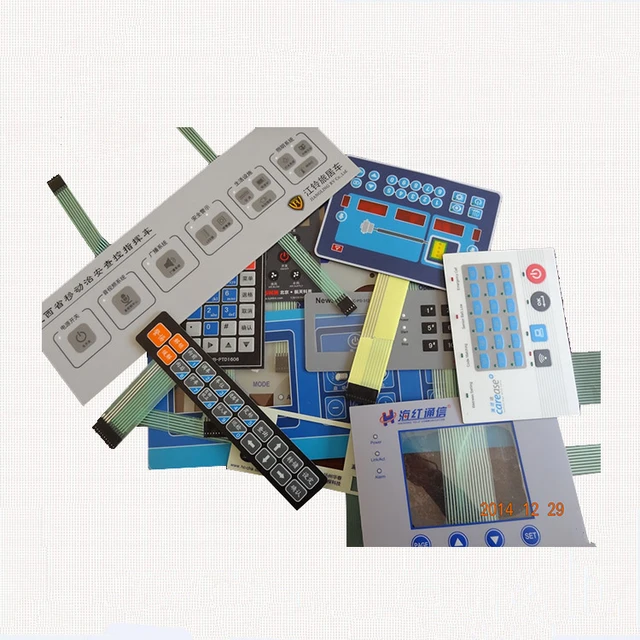Choosing the Right Membrane Switch for Your Business Needs
Choosing the Right Membrane Switch for Your Business Needs
Blog Article
Understanding Membrane Switches Over: The Key to Reputable and long lasting Controls

What Are Membrane Switches?
Membrane switches are a sophisticated service in the world of individual interface technology, incorporating performance and design effortlessly. These tools act as a user interface between users and electronic systems, incorporating several components into a portable format. Normally constructed from versatile, thin layers of products, membrane switches are designed to react to touch, enabling users to communicate with equipment and digital gadgets effectively.
The main aspects of a membrane button consist of a printed circuit layer, graphic overlay, and a spacer layer that protects against unexpected activation. The graphic overlay can be personalized to reflect brand identity or user choices, enhancing looks while ensuring use. Membrane layer switches are typically made use of in different applications, including medical devices, consumer electronics, and industrial equipment, owing to their toughness and resistance to environmental aspects such as moisture and dirt.
Among the crucial benefits of membrane layer switches is their ability to stand up to deterioration, making them excellent for high-traffic environments. Furthermore, they are lightweight and call for minimal space, enabling innovative styles in product advancement. In general, membrane switches over stand for a practical and effective option for contemporary electronic user interfaces, weding innovation with user-centric layout concepts.
How Membrane Layer Switches Over Job
The operation of membrane layer switches rest on a basic yet efficient system that translates individual input right into electronic signals. These switches include multiple layers, normally consisting of a visuals overlay, a spacer layer, and a circuit layer. When a user presses the switch, the leading layer warps, enabling a conductive component in the circuit layer to make contact with a matching conductive pad on the underside of the visuals overlay. This call shuts the circuit and sends an electronic signal to the gadget, indicating that the button has actually been triggered.
The style of membrane switches can vary, but they commonly include domes or responsive components to give feedback to the user, improving the total experience - membrane switch. The products made use of in membrane layer switches, such as polyester or polycarbonate, contribute to their resilience and resistance to ecological variables, including dampness and dust. In addition, the printed circuits are usually enveloped, which shields them from damage in time.
Benefits of Membrane Buttons

In addition, membrane buttons are her explanation recognized for their sturdiness. Constructed from durable products, they are immune to dirt, moisture, and physical wear, which dramatically expands their life expectancy compared visit site to typical mechanical buttons. This resilience makes them particularly appropriate for high-traffic environments and applications needing durability.
Another significant benefit is the convenience of cleaning and maintenance. The smooth surface area of membrane layer changes decreases dust buildup and is typically invulnerable to spills, making them suitable for setups that need constant sanitization.
Additionally, membrane buttons offer a streamlined profile, leading to a thinner layout that can be integrated into various devices without adding mass. This attribute not just boosts the visual charm but likewise adds to a much more ergonomic product style.
Applications of Membrane Buttons
Flexible and straightforward, membrane buttons discover applications throughout a wide variety of industries, including medical devices, customer electronics, and industrial equipment. In the medical field, these buttons are important to devices such as diagnostic devices, individual tracking systems, and infusion pumps, where integrity and ease of cleaning are crucial. Their capacity to withstand rough settings and preserve performance makes them suitable for such applications.

In customer electronic devices, membrane layer buttons are utilized in products like microwaves, washing equipments, and push-button controls - membrane switch. Their sleek design permits user-friendly customer interfaces, boosting the general customer experience while providing toughness and resistance to tear and wear
Industrial equipment additionally gains from membrane switches, specifically in control panels for equipment and automation systems. These switches offer security against dust and dampness, making sure consistent efficiency in challenging visit this site right here atmospheres. In addition, their adjustable features allow suppliers to customize them to certain operational demands, enhancing performance and functionality.
Picking the Right Membrane Layer Change
When choosing a membrane layer button, it is necessary to consider numerous elements that influence efficiency and viability for specific applications. The main factors to consider consist of environmental conditions, tactile comments, toughness, and layout specs.
First, assess the operating environment; switches exposed to wetness, chemicals, or extreme temperature levels call for details products to make certain longevity and functionality. Next, evaluate the requirement for responsive responses. Relying on individual interaction, some applications might take advantage of a tactile reaction to verify activation, while others may prefer a non-tactile style for aesthetic reasons.
Resilience is one more critical aspect; membrane switches should be designed to stand up to frequent use, impacts, and abrasion. Make certain the selected switch can endure the expected lifecycle, especially in high-usage situations.

Verdict
In conclusion, membrane switches over offer as important components in the design of dependable and durable control systems across different industries. The flexibility of membrane switches over permits for customized remedies that fulfill specific functional requirements, reinforcing their relevance in modern-day innovation.
Membrane changes represent an essential facet of modern-day interface design, mixing functionality with durability in numerous applications.Membrane switches are an innovative option in the realm of customer interface modern technology, combining performance and layout flawlessly. Typically created from adaptable, thin layers of products, membrane layer buttons are created to react to touch, enabling customers to connect with equipment and electronic devices efficiently.
The design of membrane buttons can differ, however they frequently incorporate domes or responsive components to supply responses to the customer, improving the general experience.In final thought, membrane layer changes offer as vital parts in the design of trustworthy and sturdy control systems throughout different industries.
Report this page